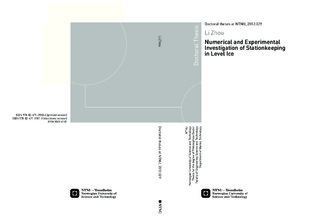| dc.contributor.author | Zhou, Li | nb_NO |
| dc.date.accessioned | 2014-12-19T12:08:31Z | |
| dc.date.available | 2014-12-19T12:08:31Z | |
| dc.date.created | 2013-01-22 | nb_NO |
| dc.date.issued | 2012 | nb_NO |
| dc.identifier | 600045 | nb_NO |
| dc.identifier.isbn | 978-82-471-3980-6 (printed version) | nb_NO |
| dc.identifier.isbn | 978-82-471-3981-3 (electronic version) | nb_NO |
| dc.identifier.uri | http://hdl.handle.net/11250/238346 | |
| dc.description.abstract | Stationkeeping method is crucial for successful marine operations in ice-covered waters. Depending on the type of structure, two methods are used in the numerical study, namely mooring system and DP combined mooring system.
For stationkeeping operations in ice, ice loads represent the dominant load and it is important to estimate global ice loads on stationkeeping structures and the resulting structures response. Therefore, focus in the present thesis is put on both numerical model for simulating ice–structure interaction during stationkeeping operations in level ice and experimental investigation of ice loading process.
The numerical model includes ice force model, mooring system model and heading control model. Ice force model reproduces continuous icebreaking process and considers the actions of ice cusps fragmented from the intact ice sheet on the structures. The mooring system mainly provides restoring forces to balance the ice loads. Heading control model is mainly used to align the ship-shaped structure with the incoming drift ice. In the simulation of an icebreaking tanker with a mooring system, the three degreeof- freedom (DOF) rigid body equations of surge, sway, and yaw are solved by numerical integration. The thickness and strength properties of the ice encountered by the structures are assumed to be constant. Accordingly the global ice loads on structures and corresponding behavior are obtained in a deterministic way.
The icebreaking tanker MT Uikku in level ice was tested in the multifunctional ice basin of the Marine Technology Group at the Aalto University. The ship model was mounted on a rigid carriage and towed through an unbroken ice sheet with different carriage speeds, heading angles of the model ship, and ice thickness. The phenomena of ice loading process were observed. The resulting ice forces, accelerations, ice cusp sizes, and ice pile dimensions under the intact ice sheets were measured. In order to validate the numerical model, the simulated results with both conical and ship-shaped structures are compared with full scale and model scale measurements. Depending on the scenario occurred to the submerged ice blocks fragmented from intact ice sheet, two ice submersion models are used in the numerical simulation. It is expected that numerical simulations can supplement full-scale tests in providing more details about the continuous icebreaking processes and the global ice load effects on stationkeeping operations of structures.
The simulation results are discussed in a case study with the tanker MT Uikku based on the heading control, in which the effects of ice thickness, ice drift speed, and global mooring stiffness on mooring forces and responses of the moored vessel are analyzed. Then the performances of the moored tanker with heading control are simulated in time domain to estimate stationkeeping capability of the tanker in level ice.
Up to now the knowledge about stationkeeping in ice is still at an early stage. The author believes that the present numerical model is suited for studies of the ice loads and dynamic response of structures with stationkeeping operation in level ice and can be extended to level ice with variable ice drift direction. It is hoped that further studies on this numerical model can supplement the full and model scale measurements in establishing a design basis for the structure stationkeeping. | nb_NO |
| dc.language | eng | nb_NO |
| dc.publisher | Norges teknisk-naturvitenskapelige universitet, Fakultet for ingeniørvitenskap og teknologi, Institutt for marin teknikk | nb_NO |
| dc.relation.ispartofseries | Doktoravhandlinger ved NTNU, 1503-8181; 2012:329 | nb_NO |
| dc.relation.haspart | Zhou, Li; Su, Biao; Riska, Kaj; Moan, Torgeir. Numerical simulation of moored structure station keeping in level ice. Cold Regions Science and Technology. (ISSN 0165-232X). 71: 54-66, 2012. <a href='http://dx.doi.org/10.1016/j.coldregions.2011.10.008'>10.1016/j.coldregions.2011.10.008</a>. | nb_NO |
| dc.relation.haspart | Zhou, Li; Moan, Torgeir; Riska, Kaj; Su, Biao. Heading control for turret-moored vessel in level ice based on Kalman filter with thrust allocation. Journal of Marine Science and Technology. (ISSN 0948-4280), 2012. | nb_NO |
| dc.relation.haspart | Zhou, Li; Riska, Kaj Antero; Moan, Torgeir. Station Keeping Capacity of a Moored Structure with Heading Control in Level Ice. ICE RESEARCH FOR A SUSTAINABLE ENVIRONMENT - THE 21ST INTERNATIONAL SYMPOSIUM ON ICE: 1069-1079, 2012. | nb_NO |
| dc.relation.haspart | Zhou, Li; Riska, Kaj Antero; von Bock und Polach, Rüdiger; Moan, Torgeir; Su, Biao. Experiments on Level Ice Loading on an Icebreaking Tanker with Different Ice Drift Angles. Cold Regions Science and Technology. (ISSN 0165-232X). 85: 79-93, 2013. <a href='http://dx.doi.org/10.1016/j.coldregions.2012.08.006'>10.1016/j.coldregions.2012.08.006</a>. | nb_NO |
| dc.relation.haspart | Zhou, Li; Riska, Kaj; Moan, Torgeir; Su, Biao. Numerical modeling of ice loads on an icebreaking tanker. Cold Regions Science and Technology. (ISSN 0165-232X). 87(0): 33-46, 2013. <a href='http://dx.doi.org/10.1016/j.coldregions.2012.11.006'>10.1016/j.coldregions.2012.11.006</a>. | nb_NO |
| dc.title | Numerical and experimental investigation of stationkeeping in level ice | nb_NO |
| dc.type | Doctoral thesis | nb_NO |
| dc.contributor.department | Norges teknisk-naturvitenskapelige universitet, Fakultet for ingeniørvitenskap og teknologi, Institutt for marin teknikk | nb_NO |
| dc.description.degree | PhD i marin teknikk | nb_NO |
| dc.description.degree | PhD in Marine Technology | en_GB |

